Plants | Term 2 Chapter 3 | 3rd Science - Questions with Answers | 3rd Science : Term 2 Unit 3 : Plants
Chapter: 3rd Science : Term 2 Unit 3 : Plants
Questions with Answers
Plants (Term 2 Chapter 3 | 3rd Science)
EVALUATION
I. Choose the correct
answer.
1. The function of leaf is to
(a) Give Support
(b) Fix the plant firmly
(c) Produce food
(d) None of the above
Answer : (c) Produce
food
2. An example for
taproot is___________
(a) Paddy
(b) Grass
(c) Mango
(d) Ragi
Answer : (c) Mango
3. ___________ supports
the plant.
(a) Root
(b) Leaf
(c) Flower
(d) Stem
Answer : (d) Stem
4. Most plants grow
from the___________
(a) root
b) leaf
(c) flower
(d) seed
Answer : (d) seed
5. Roots are poorly
developed in_________
(a) agaya thamarai
(b) neem
(c) teak
(d) date palm
Answer : (a)agaya
thamarai
6. If part X will be
absent in a plant, new plants will not be produced. X is ____
(a) stem
(b) root
(c) flower
(d) leaves
Answer : (c) flower
7. The plant is
adapted to grow in deserts as it has_______
(a) fleshy stem
(b) needle like roots
(c) leaves changed to spine
(d) both a and c
Answer : (c) leaves
changed to spine
8. An example of many
seeded fruit is________
(a) pomegranate
(b) mango
(c) apricot
(d) peach
Answer : (a)
pomegranate
9. Which of the
following plant parts take part in absorption of water and exchange of gases
respectively?
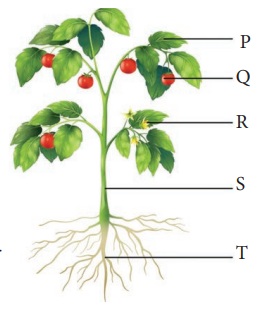
(a)
P and R
(b) R and S
(c)
S and Q
(d) T and P
Answer : (d) T and P
II. Find the odd one.
1. Carrot Radish Tomato Beetroot
2. Cabbage Greens Turmeric Spinach
3. Neem Aloe vera Datepalm Opuntia
4. Coconut Mango Apricot Orange
5. Hydrilla Opuntia Water hyacinth Vallisneria
III. Short answers.
1. Name the parts of a plant.
Root, stem, leaf, flower, fruit and seed are the parts of a
plant.
2. Name the types of roots.
Tap root and Fibrous root.
3. Write any two functions of the leaves.
• Leaf prepares food
for the plant.
• It gives
cooling effect to the plant b transpiration.
4. Write the parts of a flower.
• Petal • Sepal • Stamen • Pistil
5. Name the types of plants based on their habitat.
• Desert plants
• Coastal plants
• Mountain plants
• Aquatic plants
• Plains
plants
6. Write any two adaptations of desert plants.
• Leaves are changed into spines.
• The stem
is green and fleshy.
7. Write the names of some water plants.
Water hyacinth, Pistia, Lotus, Water lily
IV. Answer the following questions.
1. Write any two functions of each:
(a) Stem
(i) Supports the whole plant,
(ii) Transports food from leaf and water from root.
(b) Root
(i) Fixes the plant firmly to the soil
(ii) Absorbs water and minerals from the soil.
(c) Flower
(i) Develops into fruit
(ii) Helps plant to reproduce.
2. Why is leaf called
food factory of the plant?
Leaf prepares food for the plant with the help of water, carbon
dioxide sunlight, and chlorophyll. Hence it is called the food factory of the
plant.
3. Differentiate between taproot and fibrous root.

Taproot
Thick main root that goes deep into the soil.
Side roots are developed from the main root.
Fibrous root
No main root and the roots do not go deep into the soil.
Roots are developed from the base of the stem.
4. Give two examples of:
(a) Fruit having only one seed
Mango,
Coconut
(b) Fruit having many seeds
Papaya,
orange
5. Name two free floating plants.
• Water hyacinth.
• Pistia.
6. Look at the picture of a water lily.
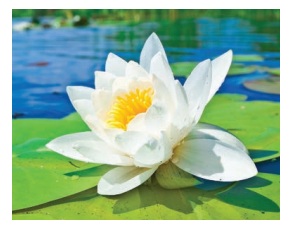
(a) Which parts of the plant can you see?
We can see the flowers and the leaves, at the surface.
(b) Where are the plant‛s roots and stem?
The plant's roots and stem are in the mud under the water.
V. Project
Collect the
information about vegetables that were cooked in your friends houses for the
last two days. Fill the table with the particulars.

From the table, answer the following questions.
(a)
In how many houses did they cook leafy vegetables? one
(b)
Which vegetable is cooked the most? Cauliflower
Warm-up
Unscramble the words and label the parts of the plant.
( ETSM, TORO, ELFA, FURTI, LOFEWR , SDEE )
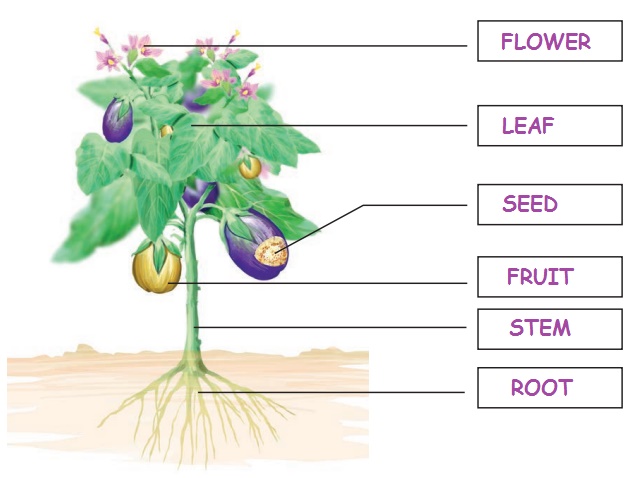
Let us Do
Take two small potted plants. Cut the root of one of the plants and fix it in the pot. Now water the plants for two to three days. You will observe that the plant without roots will wilt and die. In the absence of roots, plants die.
This acivity proves that the function of the roots is to absorb Water and Minerals from the soil.
Let us Write
True or false
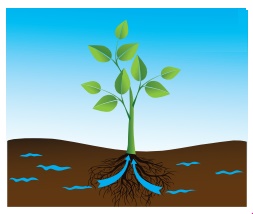
1. The roots grow into the soil. (True)
2. Fibrous root has a main root. (False)
3. Root absorbs water from soil. (True)
4. Potato stores food in its root. (False)
5. Grass has fibrous roots. (True)
Which method is easier to identify?
Touching or smelling?
Answer : smelling
Let us Do
Collect the leaves of different kinds of plants.
1. Arrange the leaves from small to big.
2. Group the leaves based on its colour.
Let us Write
Fill in the blanks.
1. Stem grows towards the sunlight.
2. Leaves originate from the Stem.
3. Green part of the plant that makes food is called Leaf.
4. Stem gives support to the whole plant.
5. Water from soil is absorbed by the root of the plant.
Think and Write
1. List out the fruits that do not have seeds. Banana, pineapple.
2. Write down the names of the fruit trees that you have never seen, but have tasted their fruits. apple, strawberry.
Let us Do
Connect the leaf with its fruit.

Let us Connect
Match the plants with their living places.
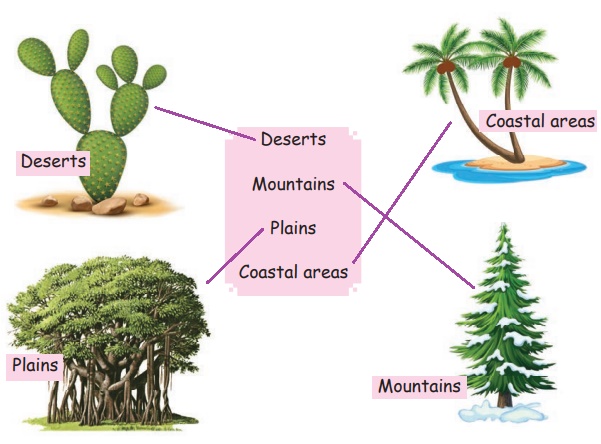
Let us Try
A. Select the ‘INCORRECT‛ statement from the following.
1. Desert plants grow in hot, dry and sandy places.
2. Plants in coastal areas tolerant to saline water.
3. Mountain plants have needle like leaves.
4. Teak is an example of desert plant. (Incorrect)
B. Tick (√) the odd one.
1. Teak Tamarind Mango Opuntia✔
2. Opuntia Aloe vera Pine✔ Date palm
C. Circle/underline the places which are land habitats.
Forest Pond Mountain River
Tree Ocean Desert Cave
Let us Try
A. Mark ‘L” for land plants and ‘W‛ for water plants.

B. Colour the Water hyacinth plant.
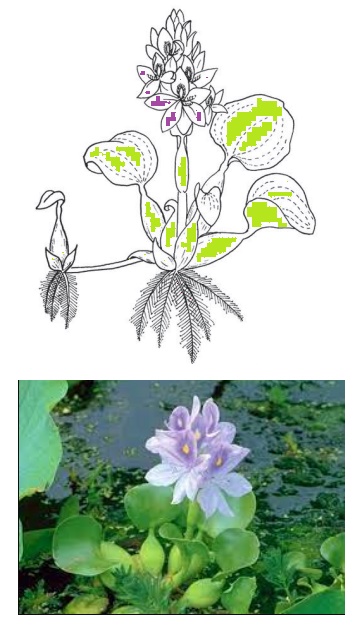
C. Write true or false.
1. Fixed rooted plants are present in water bodies. (False)
2. Leaves of lotus are submerged in the water.( False)
3. Lotus plants are found in many ponds. (True)
4. Water hyacinth freely float with the help of spongy body filled with air. (True)
Related Topics